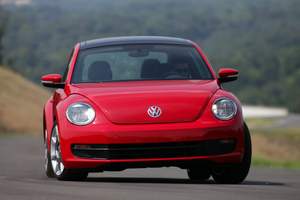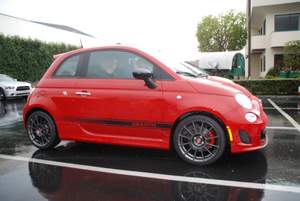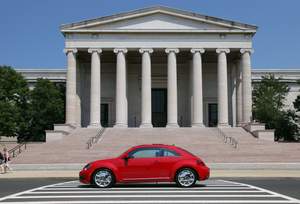
Everything old is new again. Or is it everything new is old again? The Volkswagen Beetle will do that to you.
And the third time around, it’s the VW Beetle and a diesel engine – how Sixties, you might say. But this is the latest version of the Beetle (the new Beetle that followed the New Beetle) and the latest clean diesel engine obliterates any memory of the sloth-like old Bugs and Rabbit diesels.
The 2013 VW Beetle TDI is no longer that bare-bones icon of the Sixties nor the note-perfect cute revival New Beetle of the past decade. It’s grown in dimensions and heft, shifting from a one-box design to something closer to a rounded version of the Golf two-box (which under the skin it closely resembles). With the 2.0-liter turbo-diesel engine, the Beetle will regularly turn in 40+ mpg on the highway. Around town it’s more modest, but high 20s or low 30s are reachable without having to baby the throttle. The EPA numbers are 28 city/ 41 highway with the manual and 29/39 with the automatic. As is the case with most diesels, and in contrast to most gasoline-fueled vehicles, beating EPA fuel economy numbers are not hard.
And that throttle of the TDI supplies plenty of power, again as is typical of modern diesels. The common rail systems precisely delivers the fuel to supply the giddy-up along with the aforementioned fuel economy. As the former owner of a vintage Bug, I can attest to the total transformation of what was once a pedestrian commuter vehicle into a comfortable daily driver with all of the amenities expected in the 21st century.

The Beetle Is No Longer the Entry-Level VW
Part of that transformation has been to take the Beetle from a bare-bones entry-level vehicle (and for many years the only VW most people knew) to something in the middle of the VW’s ever-expanding lineup. The lowest-cost Beetle model starts above the Jetta and Golf in price and just below the Passat. The TDI engine, a must-have for those focused on fuel economy, adds about $3,500 to the base Beetle’s price with the slick DSG automotive another $1,100 on top of that (although some other extra features are included in the TDI package compared to the base Beetle). You can save about 100 gallons of fuel a year with the diesel (compared to the base gas engine), but it might take half a decade at current or even future gas/diesel prices to make up the extra cost. However, as most diesel drivers will tell you, it’s not just the miles per gallon, but the fun per mile that helps reinforce the decision to go with that powerplant.
The Beetle is a fun car to toss around on good roads, but it also delivers a decent ride on the freeway, which is not always true of a small subcompact car. Its 100-inch wheelbase and 62-inch front track (wider than its rear track, which suggests VW designers are paying attention to subtle aerodynamics) keep the car firmly planted going over freeway joints that tend to set up an ugly pitch with many small cars. VW suggests alternatives to the Beetle are the Mini Cooper or Fiat 500, though I suspect buyers come from all over the automotive landscape since, as VW likes to say, the connection between the Beetle and its buyers is an emotional one as much one related to traditional car-buying rationales.
The Beetle, Mini & 500 – Small & Efficient
The comparison of the Beetle to what at first blush appear to be much smaller cars (the Mini and 500) may be VW’s way of rationalizing another aspect of the Beetle – it’s constricted space. That aspect is shared, along with the updated Sixties nostalgia, with the other two models. Even more so than my memories of my Sixties Bug, the back seat (maybe we were just more limber back then) is a tight squeeze to get into and has limited headroom when you get there. On the other hand, shifting from the old Bug’s rear-engine design to a front-engine configuration had given the Beetle a decent amount of storage space behind the back seat, a plus compared with the older set up. Its rounded shape does limit that storage space compared with the Mini’s squared off rear.

Another negative that comes along with the car’s “iconic” design is severely restricted rear visibility. The large C-pillar that anchors the back of the curve that defines the Beetle’s shape is functional over the right-rear, but to the left it prevents anything other than an obstructed glimpse in that direction. Another driver suggested that visibility may be a relative judgement, since she thought the VW’s rear views were significantly superior to her other daily driver, a compact sport utility. An accessory to the VW’s impairment is a rear-view mirror that also appears to appeal to historical accuracy over functionality. It’s small and, coupled with a rear window defined by the wide C-pillars, requires the driver to take at least a couple alternative views from the side mirrors to establish the presence of anything smaller than an 18-wheeler looming behind.
Comparisons with the two other retro models show them close in the fuel economy department, too. The Mini delivers anywhere from 23-to-32 mpg around town (depending on the engine and transmission) and 30-to-37 mpg on the highway with its gasoline engines, which range from 121-horsepower in the base four-cylinder up to a turbocharged model that puts out 208 hp. Of course, fuel economy and power are inversely proportional, though not as much as you might think. The Mini is the only one of the trio to offer all-wheel-drive in some of its models.
The Fiat 500, which like the Mini only offers gas engines in the U.S., will give 27-31 mpg in the city and 34-40 on the highway. It’s engines start at 101 horsepower with turbo versions bumping that up to 135 or 160 hp.
Base prices on the three retro vehicles are spread over quite a spectrum (standard equipment varies quite a bit between the different cars). The Mini Cooper starts around the same range as the Beetle ($20-21,000) while the Fiat can be had for around $16,000. If you view the TDI as the performance VW model (power plus fuel economy), it’s equivalent at Mini (the John Cooper Works) and Fiat (the Abarth) bracket it in cost. The Fiat Abarth is around $22,000; the TDI starts at $23,300 and the JCW Mini begins at $30,800.
Other than the TDI, there are two engine options with the Beetle, the base 2.5-liter five-cylinder that has 170 hp and 177 lb-ft of torque as well as 22/31 city/hwy mpg. An optional engine is the 2.0-liter turbocharged gas engine that delivers 200 hp and 207 lb-ft of torque with 21/30 city/hwy mpg. The TDI tops both in torque, particularly in the low end, which is significant since that’s the power that launches you from a start or gives you the boost you need to accelerate onto a freeway.
Overall, the Beetle TDI, even for someone without nostalgia, is an easy car to live with, as long your lifestyle doesn’t involve a substantial amount of time hauling several other adults or any large cargo. You can get used to the high mileage and sprightly performance of the car’s turbodiesel very quickly and find the 21st century version of the Bug a real answer to stylish transportation.


The vw beetle is such an amazing standard of vehicle technology. It’s great that such a classic look has transcended even to modern times. 40 miles per gallon is no joke and gives real excitement to the idea of lesser fuel dependence.
@James,
Just like the Beetles of legend, VW seems to have a good sense of how to take this icon and tweek it to get better every generation. Other than the limitations inherent in the two-door fastback design, it’s a really fun and functional vehicle, and the TDI version definitely delivers outstanding fuel economy with any loss of power.
Michael-ed.